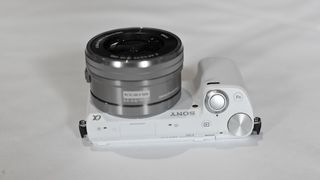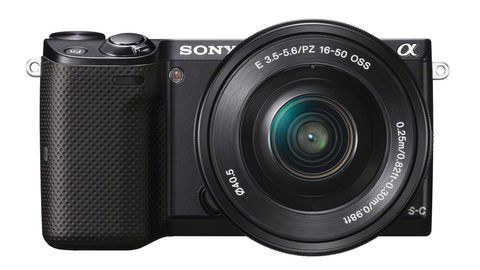Why you can trust TechRadar
Design-wise, the shape of the 5T also remains pretty much the same as its predecessor, which when paired up with a 16-50mm power zoom lens makes for a very small, neat package.
Even though it's got a larger sensor than its close rival, the Panasonic G6, it's a much smaller body, being sleek enough to fit into a large jacket pocket when using the bundled kit lens. The textured grip is chunky enough to give good purchase when holding the camera with one handed though.

In use the camera is pretty much the same as the 5R too. When using the camera in aperture priority or shutter priority, or fully manual mode, it's quite a tactile experience - using the scrolling dial with your thumb to make changes makes it quick and easy, and perhaps a little more intuitive than the 3N, which sits below it as a beginner camera.
Key functions, such as AF mode, white balance and metering, can be accessed via a function button on top of the camera. As with many other Sony cameras, this button - along with others on the back of the camera - can be customised depending on how you like to operate. It's a very nice feature that makes Sony models a pleasure to work with.
One small bugbear we've found is that the on/off switch at the top of the camera is reminiscent of the zoom switch found on most compacts, so it can be easy to get mixed up, especially if you're stepping up from a compact model. If you're using the bundled 16-50mm zoom lens, you'll need to use the zoom lever on the side of the lens to switch between wide angle and telephoto.

Having a touchscreen on a digital camera is very useful for changing the autofocus point, as well as using it to fire off the shutter release if you want to. Generally speaking, the touchscreen is pretty responsive - though it's not as slick when trying to type in something delicate such as an email address when using the Wi-Fi and apps settings, which can be a little frustrating.
The 5T is equipped with Wi-Fi and NFC, which means you can connect it to your smartphone or tablet to control it or send across images for sharing. Setting up the Wi-Fi is fairly quick, and once you've made an initial connection to the camera, your phone/tablet should remember it.
NFC is much quicker and easier to use though, if you have a compatible tablet (Apple is conspicuous by its absence here). All you'll need to do is tap the NFC logo on the 5T to the NFC logo on your device and the two should swiftly be hooked up.
Sony has made a number of apps available to download from its PlayMemories store, accessible via the camera itself. Unfortunately, these aren't very numerous, and most are relatively expensive. There's an opportunity here for Sony to up its game and make the selection more interesting: it's sadly lacking at the moment.
It's worth downloading the Direct Upload app to enable you to share directly to Facebook rather than having to go via your smartphone but, again, this could be improved to include other social networking sites such as Twitter and Instagram.
Another app facilitates adding different filters to your images, although these appear to be exactly the same as the ones that come with other NEX cameras, so we're entirely sure why this has been made into a separate app on the 5T.
You may find it beneficial to read the build quality and handling section of the NEX-5R review for a more in-depth look at the handling of this camera.
Amy has been writing about cameras, photography and associated tech since 2009. Amy was once part of the photography testing team for Future Publishing working across TechRadar, Digital Camera, PhotoPlus, N Photo and Photography Week. For her photography, she has won awards and has been exhibited. She often partakes in unusual projects - including one intense year where she used a different camera every single day. Amy is currently the Features Editor at Amateur Photographer magazine, and in her increasingly little spare time works across a number of high-profile publications including Wired, Stuff, Digital Camera World, Expert Reviews, and just a little off-tangent, PetsRadar.

Nikon Z 40mm f/2 review: this cheap, modern 'nifty forty' has been my every day lens for over a year and it hasn't let me down

Could ChatGPT be the next big cybersecurity worry — researchers say it can crack systems faster than ever before

Meta Quest's software is coming to new Asus ROG and Lenovo headsets

